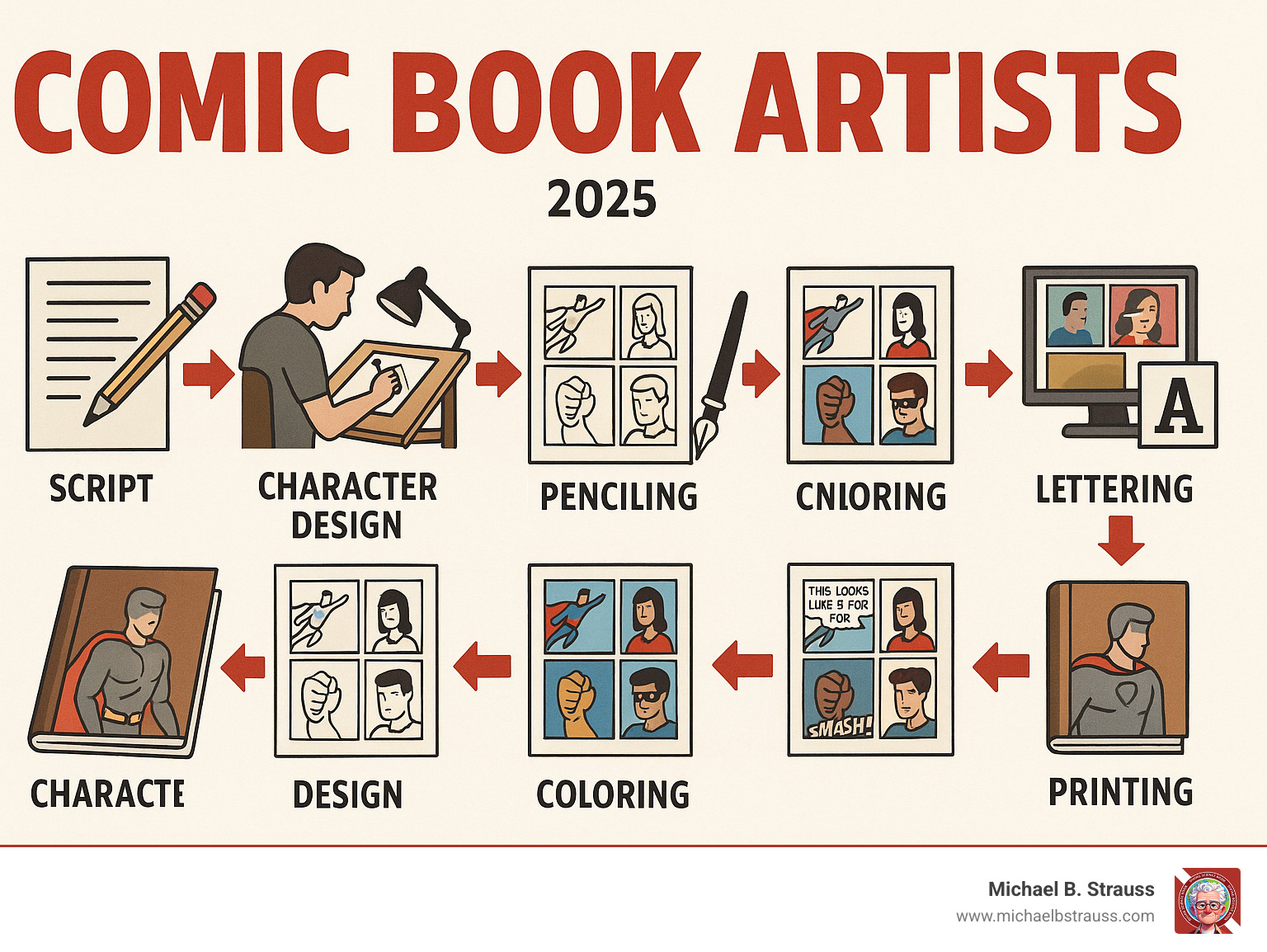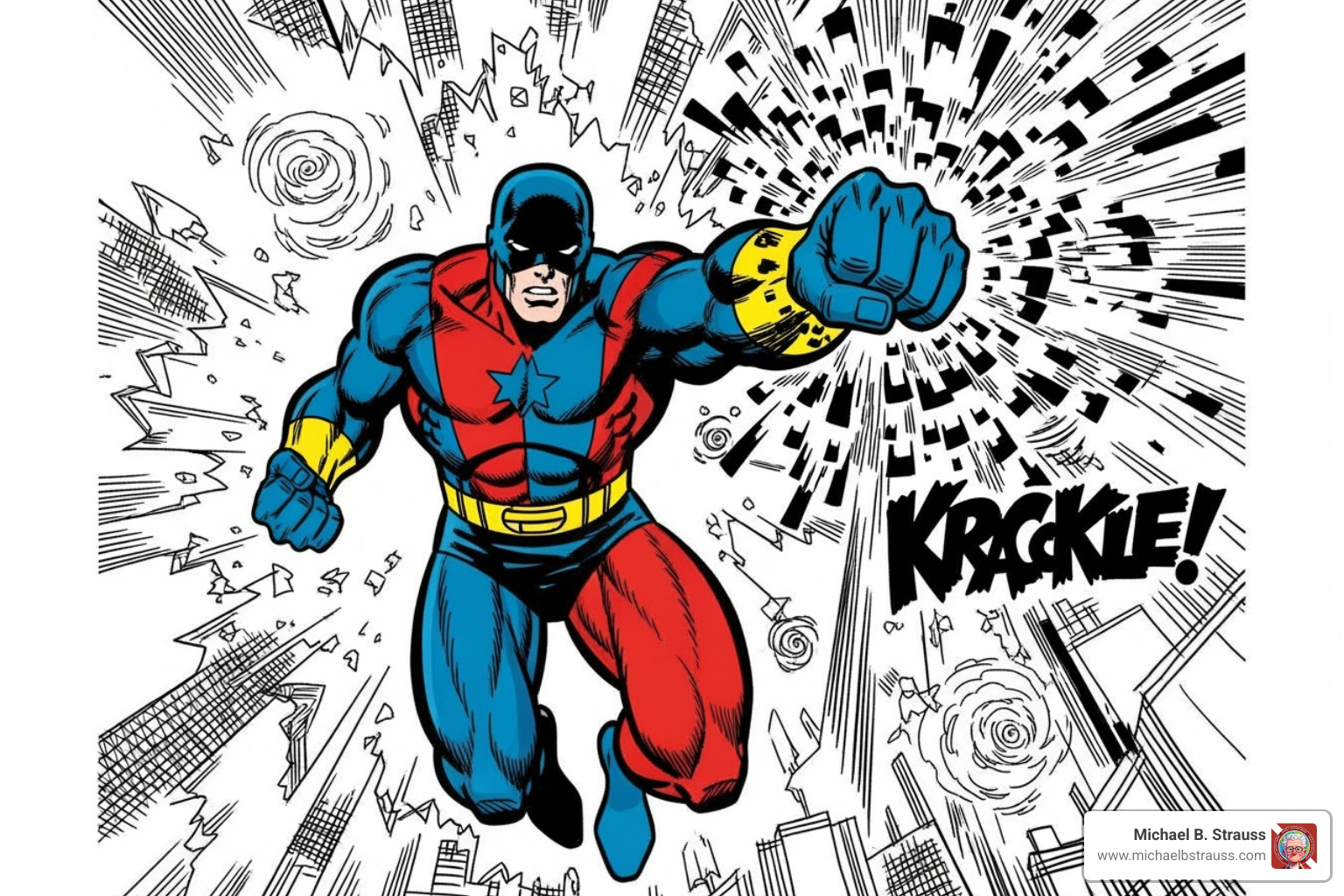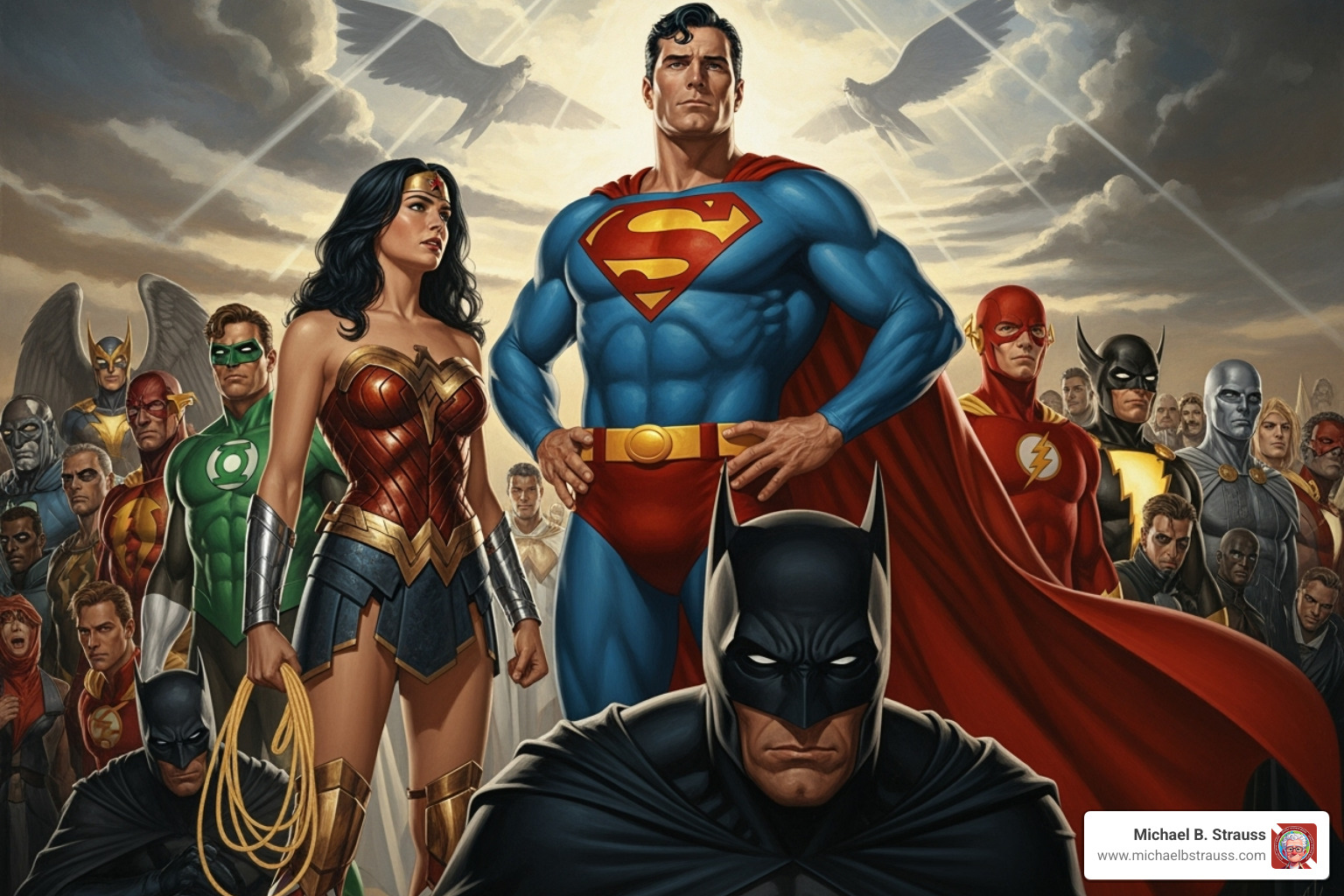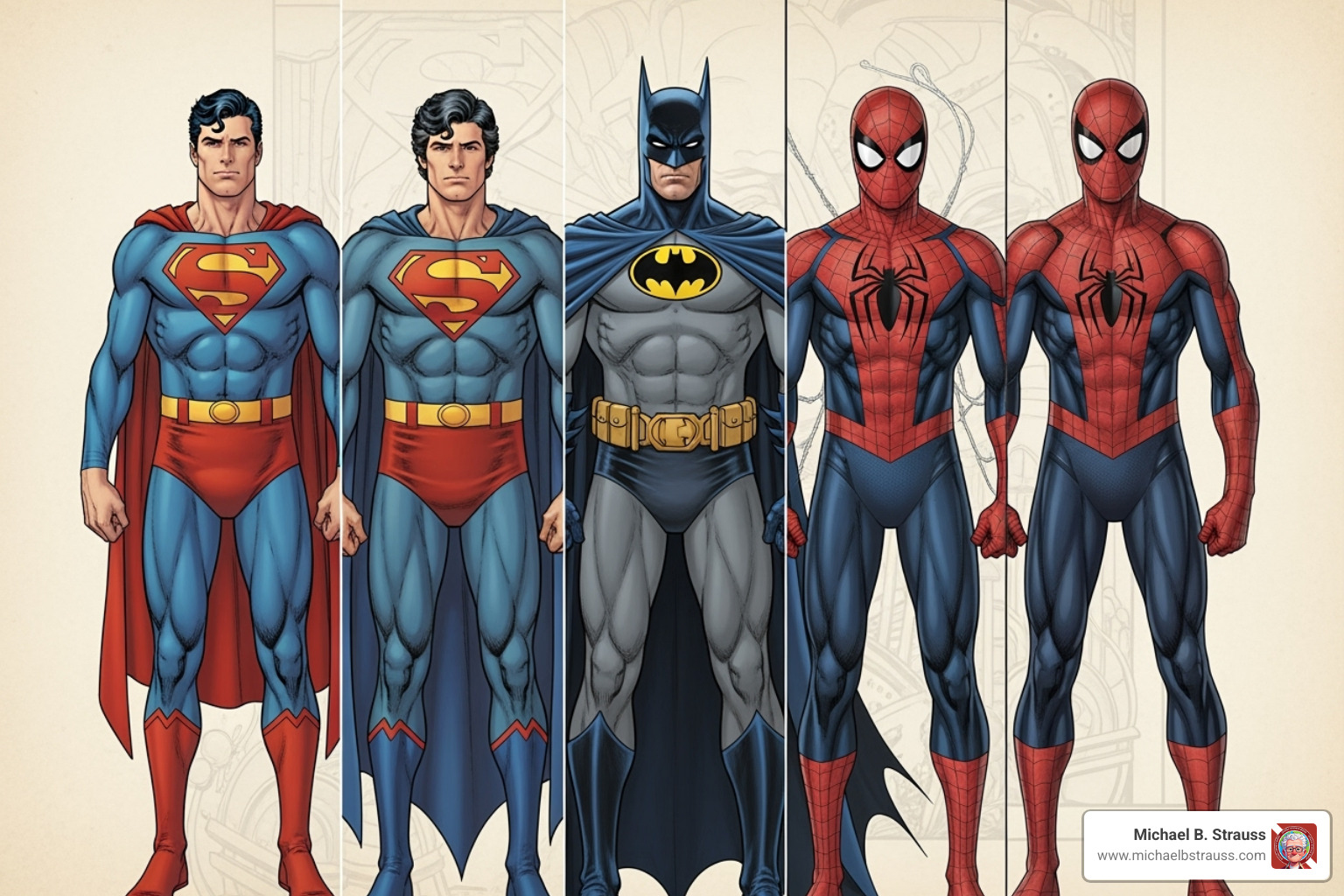More Than Just Pictures on a Page
Comic book artists are the visual storytellers who transform words into worlds, breathing life into heroes and villains with pencil, ink, and imagination. More than just illustrators, they are cinematographers working in static panels, choreographing action, designing characters, and guiding readers through complex narratives. For those who appreciate visual storytelling, whether in comics or in documenting underwater adventures, understanding artistic technique improves any creative pursuit.
Most Influential Comic Book Artists Include:
- Jack Kirby - "The King" who created the visual language of superheroes, including underwater heroes like Namor
- Steve Ditko - Co-creator of Spider-Man and master of surrealism
- Alex Ross - Photorealistic painter who lifted comic art to fine art
- Will Eisner - Pioneer of graphic novels and cinematic layouts
- Frank Miller - Known for his dark, noir-influenced style
- John Byrne - Defined iconic characters for both Marvel and DC, including aquatic adventures
- Mike Mignola - Atmospheric master of shadow and mood, perfect for depicting mysterious depths
Comic art has evolved dramatically since the Golden Age of the 1930s. Early artists like Reed Crandall and Lou Fine established foundational techniques, while the Silver Age brought innovators like Jim Steranko, who introduced psychedelic visuals. Today's artists blend traditional skills with digital tools to create sophisticated visual narratives, much like how modern underwater photographers combine technical expertise with artistic vision to capture the beauty of marine environments.
What makes these artists special is their ability to make readers feel something. As one fan noted about George Pérez, "He's irreplaceable and a benchmark for comic art." Another described Mike Mignola's work as creating an "atmosphere" that impacts "the reader's soul." This same principle applies to underwater photography and documentation - the best images don't just show what's beneath the surface, they convey the wonder and mystery of the underwater world.
From Carl Barks' Disney characters to Art Adams' "timeless" superhero designs, these visionaries have shaped comics, animation, movies, and pop culture itself. Their work reminds us that visual storytelling, whether depicting superheroes or submarine adventures, requires both technical skill and creative vision.

The Pantheon: A Look at Influential Comic Book Artists
When we celebrate the most influential comic book artists of all time, we're honoring more than just talented illustrators. These are the visionaries who fundamentally transformed the medium, breathing life into beloved characters and pioneering techniques that continue to inspire creators today. Their impact extends far beyond the page, shaping how we see superheroes, storytelling, and visual art itself.
The Architects: Foundational Comic Book Artists Who Defined Eras

Some artists don't just draw comics; they build the very foundation of the medium. These masters created the visual DNA that would define generations of storytelling.
At the top of this pantheon sits Jack Kirby, "The King" of comics. His explosive energy crackles off the page through his famous "Kirby Dots." His dynamic anatomy and powerful compositions gave us the definitive look of Captain America, the Fantastic Four, and Thor. When you picture a superhero in action, you're likely seeing the world through Kirby's vision.
Steve Ditko brought an equally transformative approach. His angular, distinctive style gave Spider-Man his instantly recognizable silhouette. More than a character designer, Ditko was a master of psychological storytelling, pushing comics into mind-bending new territories with his surreal visuals on Doctor Strange.
When Ditko left Amazing Spider-Man, John Romita Sr. stepped in and defined the web-slinger for a generation. His polished, vibrant artwork helped make the series Marvel's best-seller while co-creating characters like Wolverine and the Punisher. Similarly, John Byrne became the artist who could make any character feel definitive, breathing new life into the Fantastic Four, Superman, and the X-Men with a clean style that made complex storylines visually engaging.
The Golden Age gave us masters like Reed Crandall and Lou Fine, whose impeccable draftsmanship set a high bar. Crandall, inducted into the Will Eisner Comic Book Hall of Fame in 2009, moved seamlessly between genres, while Fine's innovative layouts shaped characters like Doll Man. Other pioneers include Jim Steranko, with his psychedelic, cinematic approach; Gene Colan, who developed a moody realism for Marvel's horror titles; Joe Kubert, who mastered dramatic poses and emotional reactions; and Gil Kane, known for his masterful understanding of human anatomy.
We also can't forget Harvey Kurtzman, the genius behind Mad Magazine whose simple art told sophisticated stories, and Carl Barks, the Disney master who created Scrooge McDuck and built the entire Duckburg universe.
These architectural comic book artists invented the visual language we still speak today. Their legacy is honored by institutions like the Will Eisner Comic Book Hall of Fame.
The Stylists: Pushing the Boundaries of the Medium

While architects built the foundation, stylists are the comic book artists who push against the walls, developing instantly recognizable voices.
Alex Ross stands in a category all his own. His gouache painting technique, showcased in Kingdom Come, brings photorealistic weight and classical beauty to superheroes, blurring the lines between comics and fine art. In contrast, Mike Mignola creates powerful atmosphere through heavy shadows and stark contrasts. Reading his Hellboy feels like stepping into a world where every shadow holds a secret.
Bill Sienkiewicz takes an experimental approach with his mixed-media style, incorporating painting and collage to pack raw emotion into every panel. Frank Quitely brings a grounded realism that feels both comfortable and unsettling, using his understanding of body language to create characters who feel like real people. David Mazzucchelli represents a perfect balance of realism and stylization, with clean linework and thoughtful compositions that serve the story with incredible clarity.
Other notable stylists include Amanda Conner, whose bright characters bring joy to the page; Chris Bachalo, with his instantly recognizable and emotional work; Terry Dodson, who blends realism with cartoon sensibilities; Tradd Moore, known for his kinetic energy in action sequences; and Jae Lee, who creates haunting, beautiful imagery.
These stylists remind us that there's no single "right" way to draw comics. The best comic book artists find their unique voice and use it to expand what the medium can express.
The Storytellers: Mastering the Art of Narrative

The greatest comic book artists are more than illustrators—they're visual directors, cinematographers, and choreographers. These masters guide readers through emotional journeys with images and white space.
Darwyn Cooke exemplified this with a clean, technical style that made complex narratives feel effortless. His comics often told stories through pure visual flow, so you could understand the plot without any dialogue. Walt Simonson also perfected letting pictures do the talking. His legendary run on Thor used dynamic compositions to eliminate excessive dialogue, making readers feel the raw power of gods in battle.
David Aja represents the modern evolution of visual storytelling. His work on Hawkeye showed how thoughtful panel design and minimalist composition could create a perfect storytelling rhythm. In contrast, George Pérez mastered storytelling through incredible detail and scope. His ability to handle massive crowd scenes without losing narrative clarity made him irreplaceable, creating rich worlds for readers to explore.
Tim Sale mastered the emotional power of light and shadow, using silhouettes and contrast to convey mood and character more effectively than pages of dialogue. Other great storytellers include Scott Kolins, who excels at character expression; Akira Toriyama, who blends intensity with charm; Marc Silvestri, whose gritty worlds immerse readers; Sana Takeda, whose beautiful art serves deep emotional narratives; and John Cassaday, who brings a human feel to superheroes through exceptional detail.
These storytelling masters understand that every artistic choice serves the narrative, elevating comics to sophisticated visual literature. For those inspired to dive deeper into the craft, you can explore more info about our resources to continue your journey into visual storytelling.
The Craft and Legacy of Comic Art
The magic of comic book artists doesn't stop when they put down their pencils. Their creations ripple outward, shaping movies, TV shows, toys, and even how we see the world around us. These visual storytellers have become cultural architects, building icons that last for generations, including many underwater heroes and aquatic adventures that have inspired real-world ocean exploration.
Beyond the Panel: The Artist's Influence on Pop Culture
When you think of Superman or Spider-Man, you're seeing the combined vision of countless comic book artists who defined these heroes over decades. Each artist leaves their fingerprint on these cultural touchstones. Notably, many comic artists have been fascinated by underwater worlds, creating heroes like Aquaman and Namor who brought ocean adventures to millions of readers.
Take Jim Lee, whose dynamic, detail-heavy style helped launch Image Comics and later revolutionized DC's universe during the New 52 reboot. His interpretation of heroes influenced animated series, video games, and blockbuster films, proving an artist's vision can reshape a company's identity. His work on Aquaman helped modernize the character for new generations.
Alex Toth showed how comic artistry translates to other mediums. His clean, powerful designs for Hanna-Barbera's Space Ghost and The Herculoids became animation classics. The versatility of artists is amazing. Wally Wood mastered everything from EC Comics' sci-fi to defining Power Girl's look. Barry Windsor-Smith gave us both the definitive Conan the Barbarian and Wolverine's haunting "Weapon X" origin.
Some artists accept constant evolution. Erik Larsen never stops experimenting, while Stuart Immonen achieves a "wild variation in work," moving between hyper-realistic and cartoonish styles.
The industry has grown to appreciate these visual masters. While writers once got most of the credit, today comic book artists are celebrated through institutions like the Will Eisner Comic Book Hall of Fame, with fans recognizing that visual storytelling carries equal weight.
Underwater worlds have particularly fascinated comic readers and artists alike. Artists like John Buscema and Gil Kane brought aquatic heroes like Namor and Aquaman to life with dynamic artwork that captured the fluid grace and power of underwater movement. Their depictions of submarine adventures and ocean exploration have inspired countless readers to learn more about the real ocean. Just as these artists explored the depths of imagination, real-world marine creatures have incredible adaptations. More info about Mammalian Divers reveals how nature's designs can be as amazing as any comic creation.

Advice for Aspiring Comic Book Artists
Dreaming of joining the ranks of legendary comic book artists? The path requires dedication, but bringing your own worlds to life - whether fantastical fields or underwater adventures - is a worthy reward. Many successful artists have found inspiration in real-world exploration, including ocean diving and marine biology.
- Master the fundamentals. You can't break the rules until you know them. Study anatomy, perspective, light, and shadow. Understanding how light behaves underwater, for instance, can add authenticity to aquatic scenes. A strong foundation is key, as seen in the detailed sketches of artists like Russ Braun.
- Think like a director. Comics are movies on paper. Understand pacing, composition, and visual rhythm to make your panels flow seamlessly, like the work of Walt Simonson and David Aja. This is especially important when depicting underwater scenes where movement flows differently.
- Develop your unique voice. Your style will emerge naturally with practice. Don't be afraid to experiment and let each project bring out different aspects of your artistic personality, as Stuart Immonen does.
- Build a killer portfolio. Show your range and storytelling ability with character designs, action sequences, and quiet moments. Include diverse environments - from cityscapes to underwater kingdoms. Your portfolio is your calling card.
- Network genuinely. Attend conventions, join online communities, and support other creators. The comic industry runs on relationships.
- Never stop learning. Study the masters.
Just as divers must understand Decompression Science before exploring the ocean's depths, aspiring artists should dive deep into their craft's history. Study how different artists solved visual problems across eras, particularly those who excelled at depicting underwater environments and aquatic adventures.
Whether exploring new worlds on the page or beneath the waves, success comes from combining passion with knowledge. The same attention to detail and safety that makes a great diver also makes a great artist - both require patience, practice, and respect for their craft. For those fascinated by underwater exploration and how it can inspire artistic creation, Learn more about Diving Science offers the foundational expertise that makes any adventure, creative or aquatic, both thrilling and safe.

Get your copy of Diving Science Revisited here: https://www.bestpub.com/view-all-products/product/diving-science-revisited/category_pathway-48.html
DISCLAIMER: Articles are for "EDUCATIONAL PURPOSES ONLY", not to be considered advice or recommendations.






